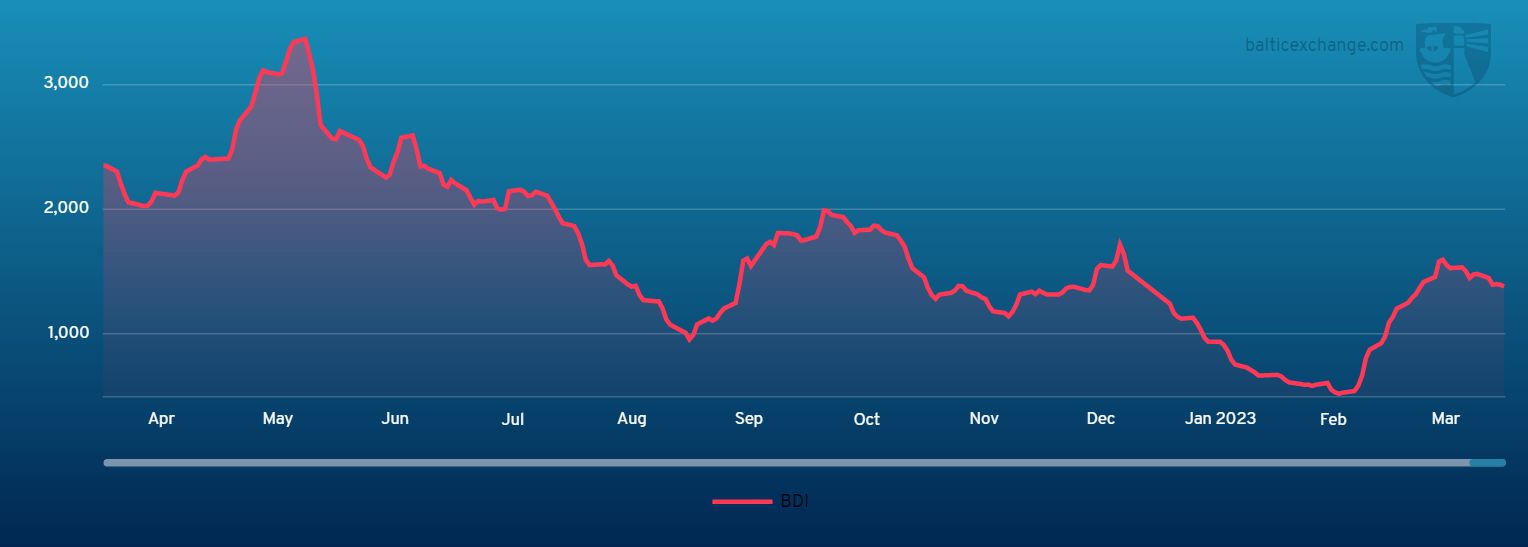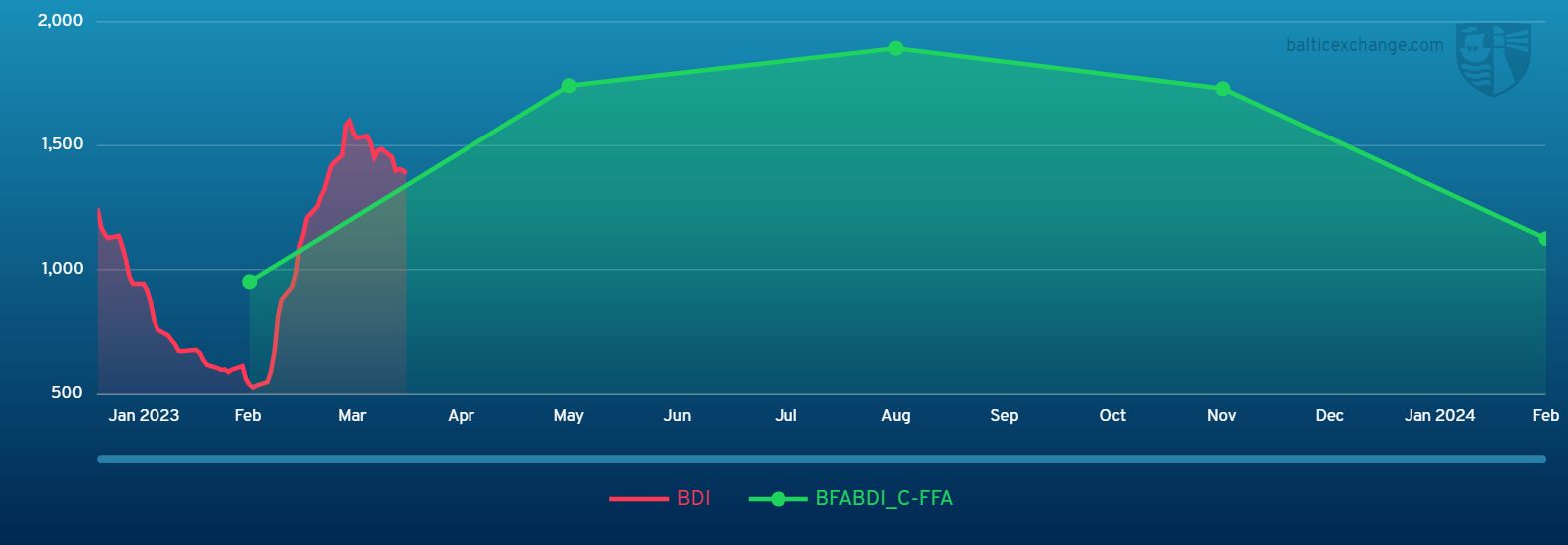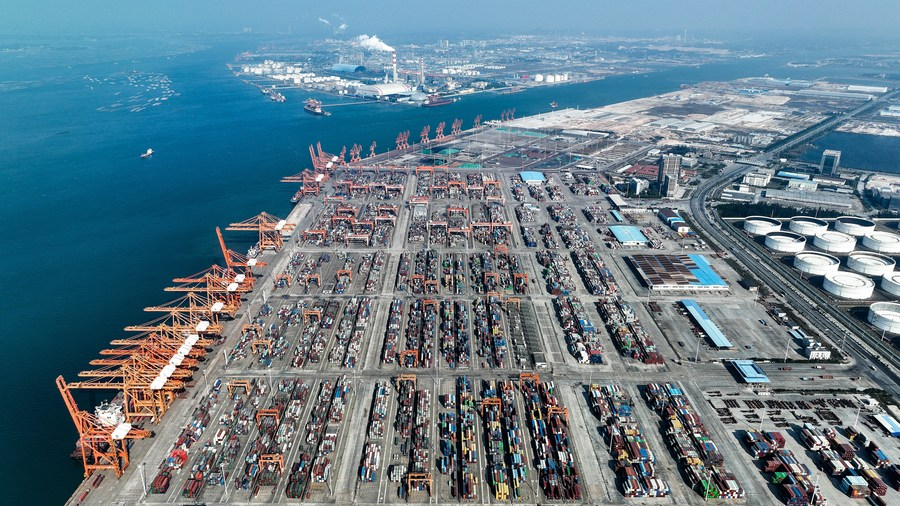BEIJING, April 3 (Xinhua) -- The Baltic Exchange has published its weekly report of the dry and tanker markets for March 27-31, 2023 as below:
Capesize
The first quarter of 2023 ended with a decline of $95 on the Capesize time charter average (5TC), pricing at $13,806 on the last day in March. This is about double in value compared with the start of the month. Brazil to Qingdao remained above $20 throughout the week and finally climbed to $21 on Friday, showing $15,150 on the China/Brazil round voyage. However, the market was still waiting for further cargo to support. On the other hand, in the Pacific, the West Australia to Qingdao run dropped from $8.41 to $7.90 with majors appearing active as usual. On the period front this week, the Cape Cynthia (180,330 2012) was reportedly fixed basis delivery Korea 20-30 April for one year to Costamare at 108 percent of the 5TC. Overall, the 5TC maintained the same level as at the start of the year.
Panamax
A volatile week for the Panamax market, with the market trend and direction altering its course. The Atlantic saw improved demand ex NC and EC South America with end April arrival dates experiencing enhanced rates midweek. A $18,250 +$825,000 delivery aps load port was perhaps the highlight. The north Atlantic returned a confusing week with some voyage fixtures returning lower than index equivalents, whilst other tonnage tightness ex Continent and Mediterranean added support to rates. It proved to be a puzzling and tumultuous market in Asia this week. This was somewhat highlighted by the distinction in rates for grain clean and non-grain clean tonnage. Excess of $15,000 was paid several times for NoPac grain tonnage on good types. Meanwhile, the mineral round trips achieved distinctively lower rates despite the support afforded ex EC South America. It was an active week for period deals, with a host concluded - including an 82,000dwt delivery China achieving $17,250 for eight to 10 months trading.
Ultramax/Supramax
A poor week for the sector across most areas. The Atlantic saw little excitement with the US Gulf and South America seeing tonnage availability grow and limited fresh cargo appearing. A similar situation from Asia, with little fresh Indonesian coal. This led to downward rate pressure for tonnage open. Period activity remained behind the scenes and a 61,000dwt open Mediterranean fixed at around $20,250 for three to five months. From the Atlantic, a 58,000dwt open West Africa fixed a trip to India at around $20,000. Further north, a 57,000dwt fixed a scrap run from the North Continent to East Mediterranean at $13,000. Similarly, in Asia, a 55,000dwt open South China fixed a trip redelivery Singapore at $10,250. A 63,500dwt also open South China fixed a trip via Indonesia redelivery WC India in the low $13,000s.
Handysize
A subdued week in the handy sector saw minimal visible activity. In the US Gulf, levels had softened with a 37,000dwt open in Port Everglades fixing basis delivery Norfolk for a trip to the UK-Ireland range with an intended cargo of grains at $13,750. In the Mediterranean, a 34,000dwt fixed from Canakkale via the Black Sea to the US Gulf with an intended cargo of minerals at $13,000 and a 37,000dwt fixed from Piraeus to the US Gulf at $14,000. In Asia, a 28,000dwt was rumoured to have been fixed for an inter-Pacific trip with an intended cargo of cement at $6,750 - but further details had yet to come to light. The period market was active in the Atlantic. A 38,000dwt fixing for two to four months basis delivery Canakkale at $13,500, whilst a 33,000dwt open in the South Atlantic was linked to being fixed for one year at $14,000.
Clean
The clean product freight market has been this week with LRs losing some of their usual alignment. TC1 has softened a touch down to WS180.63 (-WS3.43) with a TC20 run west dipping from $4,650,000 to $4,540,000. However, on the LR1s TC5 has climbed up 22.93 points to WS206.79 off the back of plenty of activity midweek. At these levels the TCE has been taken back over the $40,000 per day round trip TCE mark. TC8 also improved steadily, coming up $112,000 to $3.79m. MRs have been consistently tested and at the time of writing TC17 sits at WS240 (-WS25).
West of Suez, LRs have been muted. In the Mediterranean, TC15 shed $104,000 to $3,800,000m after a widely reported midweek fixture at this level. Up on the UK-Continent, TC16 has been resolute at the WS180 mark all week.
On the UK-Continent MR owners managed to improve freight levels, predominantly off the back of a tightened vessel supply. TC2 has jumped up 31.11 points to WS293.89 and similarly TC19 added 32.15 points to WS304.29.
In the Americas, the MR market fluctuated up and down. TC14 peaked at WS117 after climbing up from WS111.25. It then returned back down the WS110. TC18 followed suit and topped out at WS218 (up from WS205) to resettle back down to WS210. On a TC21 run to the Caribbean, the index hopped from $690,000 to $770,000 - then ended up at $675,000 after a widely reported fixture.
Handymax vessels have been relatively active. TC6 has hovered in the W450s, and TC23 was driven up to WS343 midweek only to return back to WS335.
VLCC
The VLCC market continued to fall this week. For the 270,000mt Middle East Gulf to China voyage the rate fell a further 10 points to WS80.05. This translates to a daily round voyage TCE of $68,900 per day basis the Baltic Exchange’s vessel description. The rate for 280,000mt Middle East Gulf to US Gulf (via the cape/cape routing) is assessed 5.5 points lower at WS60.61. In the Atlantic market, the rate for 260,000mt West Africa/China dropped 7.5 points to WS81.95, showing a round trip TCE of $71,700 per day. The rate for 270,000mt US Gulf/China fell a little more than $444,000 to $11,294,444 ($61,800 per day round trip TCE).
Suezmax
The Black Sea and Mediterranean markets have been a little quieter this week, with the only notable fixture from CPC being an Italian charterer reported fixing a Greek owner 135,000mt at WS167.5 with sentiment a little softer. Accordingly, the rate for 135,000mt CPC/Augusta was assessed on Thursday 15 points lower than a week ago at WS166.33 (a round-trip TCE of $86,800 per day). In the Atlantic, the USG market is still attracting owners away from West Africa although rates have arguably weakened a little. The rate for 130,000mt Nigeria/Rotterdam marginally slipped one point to about the WS140 mark (a round-trip TCE of about $64,500 per day). In the Middle East the rate for 140,000mt Basrah/Lavera eased 5 points to WS70.
Aframax
In the North Sea market, the rate for the 80,000mt Hound Point/Wilhelmshaven route settled about 1.5 points lower than a week ago at WS180 (a round-trip daily TCE of $75,800).
In the Mediterranean, the rate for 80,000mt Ceyhan/Lavera fell back after the recent sharp rise, losing nearly 36 points to be rated at a little over WS245 (a daily round trip TCE of $94,100).
Across the Atlantic, the Stateside Aframax market was significantly weaker - although the corresponding vessel earnings are still comparatively impressive.
The rate for 70,000mt East Coast Mexico/US Gulf tumbled about 91 points to just over WS285 ($98,800 per day round-trip TCE) and the rate for 70,000mt Covenas/US Gulf had 88 points slashed from assessments a week ago to just below WS270 (a daily round-trip TCE of $84,300). For the Transatlantic route of 70,000mt US Gulf/Rotterdam, the rate fell away 59 points to WS200 (showing a round trip TCE of $53,711 per day).
LNG
With more tonnage becoming available (caveated with several restrictions), there has been a softening of the spot market. Rates have sunk lower again on the back of lacklustre cargo enquiry. Discussions taking place have been, for the most part, relatively unsuccessful and rates are falling still in both basins. The Pacific BLNG1g Aus-Jap route fell another $4,185 over the week to close at $64,330 a fall of $85,295 from the start of the year. We are into the summer months and a continued push to keep inventories ready for winter will garner much of the spot market for the moment. However, as yet it has had little impact on the spot pricing.
In the Atlantic, rates suffered similar falls with BLNG2g closing at $42,532 and little else reported or discussed. For BLNG3g there was a fixture of a 2-Stroke 180cbm vsl with both East and West options, which should calculate down to a Baltic 160cbm around $52,500. But the market fell further from here and closed at $50,295 for a USG-Japan run. Part of this downturn is explained by the macroeconomic news where gas inventories have been high, and a milder winter has kept usage lower. With strike action affecting some European countries there is potential for an uptick. Countries who have eaten into their reserves could look to replenish stocks, but this might be slow and the rates for spot currently remain unaffected.
Our current estimations for a 174k 2-Stroke vessel with 0.085 percent boil off and delivery one month ahead: $175,500 for 12 months, and $147,500 for 3-Years.
LPG
A dismal week for the LPG market and all three routes suffered casualties as rates dropped significantly. BLPG3 lost 28.61 percent of its value. And in the East, with a cargo going on subs for AG-East at $73, the market fell by over $10 in one day. A lack of cargoes and longer tonnage list all contributed to softening sentiment. Owners were keen to fix away at much lower rates to secure cargoes rather than sitting and waiting with nothing to show for it. The market didn’t regain any steady footing and rates fell $19 to close at $69.286 with a TCE return of $51,744 for a round voyage.
The West fared just as badly, a Houston-Chiba run lost huge grounds shaving $39.286 over the week. Although BLPG2 survived better, the lack of cargoes and interest in Houston-Flushing made this run more difficult to assess. Owners have had to wrestle with delays in the Panama Canal, but locking in for longer voyages was seen as the prudent course of action - even at diminishing returns. The market has fallen, but rates are still high historically speaking. For BLPG3 a high of $137.286 to the low close of $98 (a TCE equivalent of $37,516) we have seen the market crashing below triple digits.
Headquartered in London and a subsidiary of the Singapore Exchange (SGX), the Baltic Exchange publishes a range of indices and assessments which provide an accurate and independent benchmark of the cost of transporting commodities and goods by sea. These include the Baltic Dry Index (BDI), the dry bulk shipping industry's best known indicator. Published daily since 1985, this provides a snapshot of the daily spot market earnings of capesize, panamax and supramax vessel types on the world's key trading routes.

Chart shows Baltic Dry Index (BDI) during March 31, 2022 to March 31, 2023

Baltic Forward Assessment for BDI
In March 2018 the BDI was re-weighted and is published using the following ratios of time charter assessments: 40 percent capesize, 30 percent panamax and 30 percent supramax. The information is provided by a panel of international shipbrokers.
(Source: The Baltic Exchange, edited by Niu Huizhe with Xinhua Silk Road, niuhuizhe@xinhua.org)




 A single purchase
A single purchase









